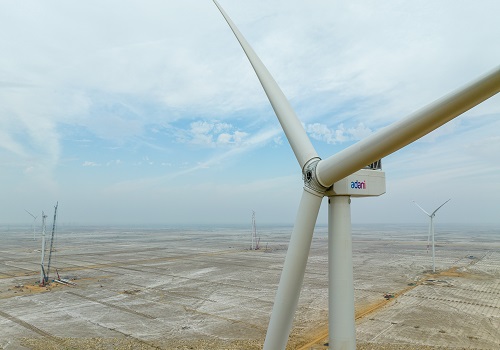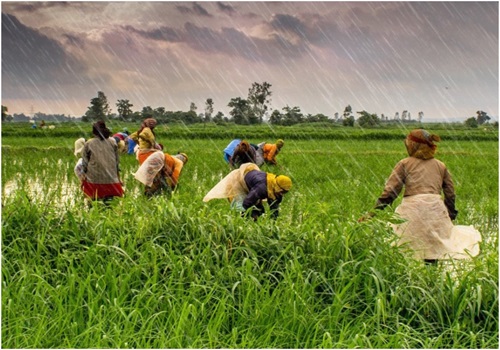2024-02-19 11:34:07 am | Source: Geojit Financial Services Ltd

Agri Commodity Technical Report 19 February 2024 - Geojit Financial Services

- Farmers in Gujarat have sown crops across 14,651 ha for the 2023-24 summer season as of Monday, according to data released by the state agriculture department. Last year, farmers in the state had not started sowing crops during this time. However, the normal acreage for the season, which is the average of the last three years, is 1.1 mln ha. Bajra, rice, sesamum and moong are the main crops grown in the state during summer. The area under bajra, the key crop grown during summer, was just 26 ha, while the normal area for the crop is 290,063 ha. Paddy was sown over 6,679 ha, while the normal area under the crop is 75,157 ha, the data showed. Paddy is the second major cereal grown in the state. Maize was sown over 841 ha, while the normal area is 6,322 ha. The total area under cereals was 7,546 ha, which is 1.7% of the normal acreage of 371,542 ha for the season. The pulses grown during the season are urad and moong. The acreage of pulses was at 1,032 ha, while the normal acreage is 79,978 ha. Moong was sown over 1,014 ha as of Monday, the data showed. The normal acreage for oilseeds is 167,769 ha, but it has been sown over 814 ha only as of Monday. Groundnut and sesamum are the main oilseed crops sown during the season. So far, groundnut has been sown over 406 ha and sesamum over 408 ha. The area under vegetables was 1,898 ha, while the normal acreage is 102,779 ha. Onions were sown over 130 ha and sugarcane over 1,396 ha, the data showed.
- The area under rabi crops in Telangana was 6.08 mln acres (1 acre = 0.40 ha) as of Wednesday, 7.7% lower than 6.59 mln acres a year ago, according to data from the state government. The acreage so far accounts for 110.8% of the normal rabi crop area of 5.5 mln acres for the entire season, the data showed.The area under pulses fell 26% on year to 316,182 acres. Acreage of Bengal gram was down nearly 29% on year at 255,003 acres. The normal rabi acreage for pulses is 421,163 acres. Maize, Bengal gram, jowar, and groundnut are the main rabi crops grown in the state.The total area under major millets, which includes jowar, bajra, maize and ragi, rose to 813,656 acres from 728,826 acres a year ago, the data showed. Maize was sown over 603,981 acres, lower than 611,538 acres a year ago. The season's normal area for maize is 511,521 acres, and it covers the maximum area under major millets, as per data. Jowar, the second-major millet in the state, was sown over 207,603 acres, nearly 78.3% higher than 116,405 acres a year ago.Paddy sowing fell 9% on year to 4.63 mln acres. The season's normal acreage is 4.05 mln acres. The area under food grains fell 7.5% on year to 5.77 mln acres.Oilseed acreage was at 260,906 acres, down from 302,784 acres a year ago. Groundnuts accounted for 79.5% of the total oilseed acreage at 207,521 acres, down from 239,808 acres a year ago. The normal area for oilseeds in the season is 371,037 acres.Telangana received scanty rainfall at 0.2 mm in January, and so far, the cumulative rainfall in the year has been normal at 914 mm, the data showed. The water level in major reservoirs in the state as of Wednesday was 319.2 bln cu ft, down from 517.8 bln cu ft a year ago, according to government data.
- India's oilmeal exports in January rose 1.1% on year to 477,580 tn, according to data released by The Solvent Extractors' Association of India today.Exports of soymeal in January rose to 375,360 tn from 110,139 tn a year ago. "International demand for Indian soya meal has benefited from improved price competitiveness and the shortage of Argentine export supplies," SEA said in a press release.For Apr-Jan, total oilmeal exports rose 21% to 3.97 mln tn, the data showed. Soymeal exports in Apr-Jan rose to 1.59 mln from 556,886 tn a year ago. In the same period, mustard meal exports fell to 1.89 mln tn from 1.91 mln tn a year ago. In January, exports of mustard meal fell to 71,472 tn from 238,476 tn a year ago, and exports of castor seed meal fell to 30,748 tn from 38,847 tn a year ago, the SEA said. "In case of rapeseed meal, export from India reduced during January, mainly due to lean crushing season coupled with high local prices, made the Indian rapeseed meal expensive for the export," SEA said in a release today.In Apr-Jan, 1.27 mln tn oilmeal was exported from the Kandla port, against 998,173 tn a year ago, and a total of 1.26 mln tn was exported from the Mundra port compared with 1.05 mln tn in the year ago period, SEA said.During the same period, exports from Jawaharlal Nehru Port Trust in Mumbai rose to 336,320 tn from 238,671 tn a year ago, the association said. Around 110,223 tn of oilmeal was shipped from the Kolkata port, compared with 343,341 tn a year ago, and 996,775 tn from other ports compared with 656,654 tn in the same period last year, the association said. During Apr-Jan, India's oilmeal exports to Bangladesh jumped 94.6% on year to 708,460 tn, while exports to Vietnam fell 49.6% to 378,966 tn, the data showed. Oilmeal exports to South Korea were at 766,424 tn, lower than 806,725 tn a year ago, the data showed.In the case of rice bran meal, there were no exports from India in January compared with 78,956 tn exported in the corresponding period a year ago, according to the data.
- The government has raised the base import prices of most edible oils by $4-$6 a tn, the Central Board of Indirect Taxes and Customs said in a notification late on Thursday. The central government levies import duty ad valorem and reviews base prices depending on changes in global prices and foreign exchange rates, usually on a fortnightly basis. The base import prices of edible oils were last revised on Jan 31. The government has raised the base import prices of refined, bleached, and deodorised palmolein as well as of crude palmolein by $4 a tn each. The base import price for refined, bleached and deodorised palm oil was raised by $4 and crude palm oil by $6 a tn. However, the Centre has cut the base import duty on crude soyoil by $22 to $903 a tn. India is the world's largest importer of edible oils. Palm oil accounts for the bulk of imports, with most of it purchased from Indonesia and Malaysia, the world's top producers of the commodity.
- Production of crude palm oil in Malaysia fell 9.6% on month to 1.40 mln tn in January, according to preliminary data from the Malaysian Palm Oil Board. Exports of palm oil in January fell 0.9% on month to 1.35 mln tn. Biodiesel exports climbed 127.4% on month to 40,559 tn, the data showed. Palm oil is also used to make biofuel. Total stocks of palm oil in the country were down 11.8% on month at 2.02 mln tn in January. Malaysia is the world's second-largest producer of crude palm oil, and India is the largest consumer of edible oils.
For More Geojit Financial Services Ltd Disclaimer https://www.geojit.com/disclaimer
SEBI Registration Number: INH200000345
Disclaimer:
The content of this article is for informational purposes only and should not be considered financial or investment advice. Investments in financial markets are subject to market risks, and past performance is not indicative of future results. Readers are strongly advised to consult a licensed financial expert or advisor for tailored advice before making any investment decisions. The data and information presented in this article may not be accurate, comprehensive, or up-to-date. Readers should not rely solely on the content of this article for any current or future financial references.
To Read Complete Disclaimer Click Here
Latest News

India`s eSankhyiki?data platform cruises to 134 mn r...

HUL`s profit up 19 pc in Q3, acquires 90.5 pc stake ...

Daily Market Commentary : Nifty IT gained traction o...

Daily Market Analysis : The Markets Rebound After Vo...

Post-Market Comment by Mandar Bhojane, Research Anal...

Quote on Market Wrap by Shrikant Chouhan, Head of Eq...

WEF: 5 new Indian industrial clusters commit to econ...

Sensex jumps 566 points, Nifty holds at 23,000 as US...

Centre hikes MSP of raw jute by Rs 315 for 2025-26 s...

WEF 2025: Urban mobility a major focus for Telangana...













